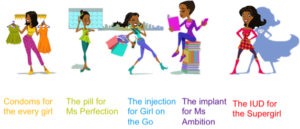The first step in an audience analysis is data gathering. This can be done by reviewing past experiences, conducting research or analyzing secondary data. Information that is typically gathered to inform the audience analysis includes the following:
- Demographic characteristics – Sex, age, language, religion, income levels; where the audience lives, where they work, proximity to services
- Psychographic characteristics – Emotional needs (for example, to be respected, to feel valued); hopes, concerns and aspirations; thoughts; beliefs; knowledge; and actions related to the health issue or service
- Preferred media – Where does the audience prefer to get health or health service information? What sources do they trust and consider reliable?
- Other opportunities to reach the audience – Are there events, groups the audience belongs to or other occasions that the audience considers a credible and preferred source of information?
- Current behaviors related to the targeted behavior – Do they currently access the targeted service or not? Do they talk to their spouse/partner about the service?
- Barriers to improved behavior – What limits their ability to adopt the service or maintain the behavior (for example, lack of transportation, low ability to pay, lack of awareness, lack of knowledge, negative attitudes, low risk perception, lack of time)?
- Facilitators of improved behavior – What things encourage or help facilitate the audience to adopt the desired behavior change (for example, skills, motivations, awareness, positive norms)?
- Gender’s impact on individual behavior and on a person’s ability to change (for example, women are not allowed to spend much time out of the home, which limits their ability to get to health clinic)
Capture this information in the Audience Characteristics and Behavioral Factors Template:
Download Audience Characteristics and Behavioral Factors Template
In addition to gathering information directly about the audiences, it can also be useful to gather insight about their experience with services – particularly if the service communication strategy is to create demand or sustained use of an existing service. This information will provide important additional insights into the audience’s needs.
Every health service has “touch points,” or occasions when the consumer comes in contact with the clinical service. These contacts happen throughout the three stages of service delivery. Clients begin interacting with the service before they even enter the facility. Radio spots, call-center interactions, promotional billboards or interactions with outreach workers may all be touchpoints for the service. Once a client enters the facility, the waiting room, the admission staff, and the clinical counseling room all become touch points during service delivery. And after a client leaves the clinic, they may interact with peer educators, call-center support staff, community referral points, and more media. All of these touch points combine to create an image and an experience for the client, which may be positive or negative.
To gather this information, it may be helpful to conduct a touch point analysis. The inputs for this analysis may include observations of the clinic and routine services, client feedback, mystery client visits, quality assurance and/or quality improvement visits.
This information can be combined in a client journey worksheet as part of the audience analysis. The worksheet can be completed in the following manner:
- Touch points: List the different moments at which the client may come in contact with the existing service or information about the service, including promotional billboards, a website, referral points, a call center.
- Expectation: List the standards for quality and/or what the client should expect to see and experience at each touch point. For example, billboards should be attractive and present clear information about the service and where it is available; waiting rooms should be clean and orderly; the provider must meet quality standards for counseling procedures and provides correct information; and counseling materials should be well maintained and informative.
- Observation: Indicate what was actually observed and any feedback received, if this information was gathered from clients (for example, outdoor media is faded and illegible; key messages are unclear; counselors did or did not answer client questions).
| Touch point | Expectation | Observation |
|---|---|---|
For complete step-by-step guidance on how to gather and analyze audience data, see How to Do an Audience Analysis.
Divine Divas
In Zambia, MSI and IDEO did in-depth client research before developing their concept and materials. The project’s primary audience was teenage girls, with the aim of encouraging them to use family planning. The project team spent lots of time with adolescents, seeking to understand their cares, barriers to seeking services, what they like to do, and what inspires them. Some of their findings included:
- Adolescent boys want to date “divas”
- Contraception is usually talked about in clinical terms that adolescents find confusing
- Teenage girls feel more comfortable talking about sex and contraception in fun, social settings
- Teenage girls have ambitions for the future and are concerned about unplanned pregnancy
The result was the creation of the Divine Divas concept – five cartoon characters that represent different contraceptive methods. The Divas bring the methods to life in terms teenage girls can understand and connect with the teens’ self-visions and aspirations for the future. These Divas are at the center of all the communication materials. The project also created Diva Centres where the teenage girls can come paint their nails and discuss sex and contraception in a relaxed setting and access services. Read more about the Divas.


